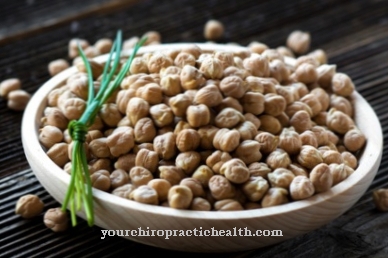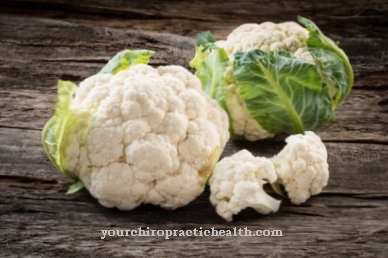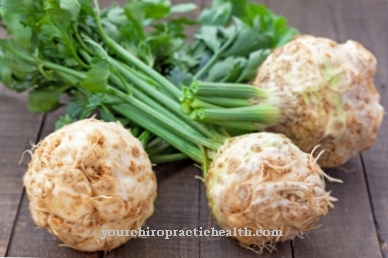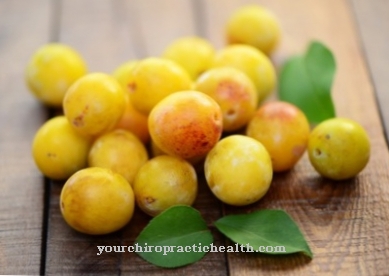Mutations of the peach with smooth instead of furry skin are called Nectarines designated. This means that they belong to the genus Prunus and the rose family (Rosaceae). Because of their surface, they are also called Smooth- or Nude peach designated.
What you should know about nectarine

The nectarine is also very similar to the peach in terms of color, pulp and shape. Nevertheless, there is no risk of confusion due to the skin. Inside, the nectarine is yellow, white variants light yellow. The stone is also reminiscent of that of the peach. It is not uncommon for nectarines to grow on peach trees. In this way, a nectarine stone can also become a peach tree.
This is because of mutations, as the skin of the nectarine is a recessive feature in the genetics of the peach. Nectarine trees reach heights of up to eight meters. The side that faces the sun is colored reddish. At the turn of the century, nectarine was already known in Greece, Persia and China. It has been planted and cultivated in England since the 17th century. At the time, however, it was far less popular. Their popularity has increased especially in the last few decades, to which the United States made a significant contribution through their breeding.
The nectarine is mainly cultivated in France, Greece, Italy, California, Spain, South Africa and Chile. The tree needs a warm climate. It is sensitive to frost and only thrives in Germany in mild areas with vineyards. These include, for example, the Rhineland and the Palatinate. There are around forty different types of nectarine in the main growing countries. This includes, for example, new variants with flat and flat shapes. Fully ripened nectarines taste sweet and fruity. They have a very juicy consistency. However, if they are still immature, their taste is more sour or bitter.
The flesh is a little firmer than the peach and the white nectarines develop a stronger aroma than the normal ones. The assumption that nectarine is a mixture of plum and peach is wrong. Still, the urban legend persists.
Seasonally, nectarines from Italy and Spain come to German supermarkets from April. In the southern countries, however, the harvest does not begin on a large scale until summer. The high season here is between July and September. In winter the fruit comes from Chile, South Africa and Argentina. Nectarines can be found in stores all year round.
Importance to health
Nectarines are not only very healthy, but also virtually fat-free and extremely low in calories. This makes them particularly suitable for figure-conscious people and a good alternative for confectionery and milk ice cream in summer. They refresh and provide fluid. The pulp also contains large amounts of vitamins and minerals that the body needs to stay healthy. In general, the nectarine is more nutritious than a peach. The reason for this is the lower water content in nectarines. It is rich in sugar and therefore a good source of energy.
The seeds of the nectarine should not be eaten, however, as they are extremely toxic if consumed in excess. They contain amygdalin. The substance splits off hydric acid and contains 8% in the seeds.
Ingredients & nutritional values
| Nutritional information | Amount per 100 gram |
| Calories 44 | Fat content 0.3 g |
| cholesterol 0 mg | sodium 0 mg |
| potassium 201 mg | carbohydrates 11 g |
| protein 1.1 g | vitamin C 5.4 mg |
100 grams of the fruit only contain around 50 calories. The fat content is just 0.3 grams. But nectarines have around 11 grams of carbohydrates and around 2.2 grams of fiber. With the same amount of fruit, there are 1.1 grams of protein. In addition, nectarines contain various vitamins that make the fruit particularly healthy. One of the ingredients is beta carotene. In addition, there are vitamin E and various B vitamins.
In μg amounts, nectarines also contain folate. With 5.4 milligrams of vitamin C per 100 grams, nectarines are not among the best suppliers, but they still contribute to an adult's daily vitamin C requirement. The fruits also contain provitamin A, which is converted into vitamin A in the body, as well as calcium, potassium and iron. The minerals contribute to the maintenance of bones and nails and help with blood formation and oxygen transport within the human organism.
Intolerances & allergies
Nectarines are of great importance from an allergological point of view, as they, like peaches and various other types of fruit, can trigger an oral allergy syndrome. This is a hypersensitivity reaction of the body to the ingredients of the fruit, which mainly occur in the mouth area.
Symptoms include an itchy roof of the mouth, swelling or blisters in the mouth, tenderness, or a tingling sensation on the tongue. It can also lead to pain and allergic reactions in the gastrointestinal tract. These can manifest in the form of gas, diarrhea or heartburn. The latter is due to the high acid content in the nectarine, which can cause discomfort in some people.
Birch pollen as well as hazel or alder can also trigger cross-allergies, which are noticeable in both nectarines and peaches.
Shopping & kitchen tips
The appearance of the skin is particularly important when buying nectarines. If it is sunken, wrinkled and soft, the fruit has already been lying too long. The condition should be unharmed and full. Often nectarines are sold in an unripe state due to their shelf life.
At room temperature they usually ripen after two to three days and are then particularly sweet and juicy. However, if nectarines are already ripe when you buy them, they should be consumed as quickly as possible, as they rot quickly. However, the fruit will keep for a few days in the refrigerator's vegetable drawer. Preparing nectarines is easy. They should be rinsed under running water due to possible pesticides or pollutants.
After dabbing dry, they can either be eaten straight away or cut in half lengthways. Then the stone can be removed and the fruit can be eaten. Depending on the preparation, the halves are cut into wedges or cubes.
Preparation tips
The fruit is particularly suitable for compotes or the preparation of jams. Nectarines are often used as a topping for summer cakes or pies. But they are also suitable for fruity desserts. Fruit slices on ice cream are particularly popular. Nectarines give the food a summery, fresh aroma.
Other options are the preparation of spirits from the juice of the nectarine. They are generally suitable as a basis for various drinks - including juices.
Nectarines can also be used not only for sweet dishes, but also for savory foods. They are particularly good in salads, but can also be served with poultry or other meat. The reason for this is their sour note. In Asian cuisine in particular, the fruit is also popular in cooking and is often used in everyday dishes.

















.jpg)







.jpg)


